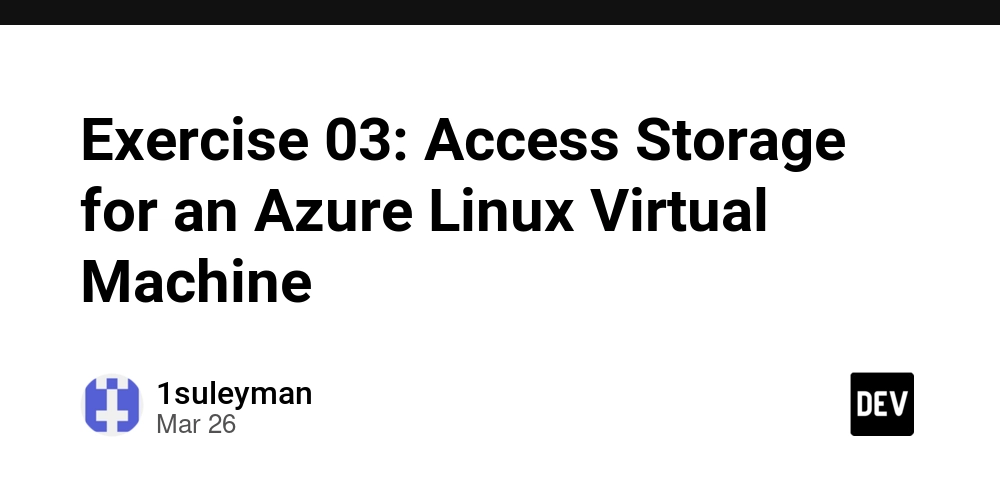Exercise 03: Access Storage for an Azure Linux Virtual Machine
Introduction In this exercise, I learned how to integrate an Azure Linux virtual machine (VM) with Azure storage. This involved creating and attaching a data disk, accessing an Azure file share, and using AzCopy to transfer files from Azure Blob Storage to the VM. The goal was to explore how Azure storage solutions can be utilized for VM data management. Scenario The task was to set up storage for the Linux VM, specifically: Add a data disk to the VM. Access an Azure file share from the VM. Copy files from Azure Blob Storage to the VM's data disk using AzCopy. Skills Practiced Creating and configuring a Linux virtual machine using the Azure CLI. Attaching and mounting a data disk to the VM. Accessing an Azure file share from a Linux VM. Using AzCopy to transfer files from Azure Blob Storage to a VM. Step-by-Step Guide Step 1: Create a Virtual Machine and Add a Data Disk 1️⃣ Sign in to the Azure Portal I logged into the Azure portal and navigated to Cloud Shell in the top right corner. 2️⃣ Create a Virtual Machine using the Azure CLI I created a new Linux virtual machine using the following CLI command: az vm create --name vm3 --resource-group rg1 --image Ubuntu2204 --admin-username adminuser --generate-ssh-keys --location eastus 3️⃣ Attach a Data Disk to the VM After creating the VM, I attached a 4 GB data disk using the following command: az vm disk attach --resource-group rg1 --vm-name vm3 --name Disk1 --new --size-gb 4 4️⃣ Verify the Data Disk I verified the disk was successfully created by using the command: az disk list --output table Step 2: Connect to the Virtual Machine and Configure the Data Disk 1️⃣ Connect to the VM via SSH I connected to the VM using SSH: ssh -i ~/.ssh/id_rsa.pem adminuser@ 2️⃣ Partition the Data Disk Once connected to the VM, I used the following commands to format and partition the new data disk: lsblk -o NAME,SIZE,MOUNTPOINT sudo parted /dev/sdc --script mklabel gpt mkpart xfspart xfs 0% 100% sudo partprobe /dev/sdc sudo mkfs.xfs /dev/sdc1 3️⃣ Create a Mount Point I created a directory for the mount point: sudo mkdir /datadrive sudo mount /dev/sdc1 /datadrive 4️⃣ Verify the Data Disk Mount I verified the disk was mounted and there were no files present: df ls /datadrive Step 3: Access an Azure File Share from the Virtual Machine 1️⃣ Create a Storage Account and File Share I created a storage account and a file share named share1: Storage account name: az104bobstg1 Region: East US File share name: share1 2️⃣ Grant the VM Access to the File Share I enabled the system-assigned managed identity for the VM, which allowed it to authenticate to the Azure storage account. 3️⃣ Run the Connect Script I generated a connection script in the Cloud Shell and ran it to mount the Azure file share on the VM: sudo mkdir -p /mnt/share1 sudo mount -t cifs //.file.core.windows.net/share1 /mnt/share1 -o vers=3.0,username=,password=,dir_mode=0777,file_mode=0777 4️⃣ Verify the File Share After mounting the file share, I checked the files inside: ls /mnt/share1 Step 4: Copy a File from Azure Blob Storage to the Virtual Machine Data Disk 1️⃣ Create a Blob Storage Container and Upload a File I created a Blob Storage container named data and uploaded a file, blobimage.png, to it. 2️⃣ Assign the VM the Storage Blob Data Contributor Role I granted the VM the Storage Blob Data Contributor role to the storage account, allowing read and write access to the blob container. 3️⃣ Install AzCopy on the VM I installed AzCopy on the VM to enable easy transfer of files from Blob Storage: wget https://aka.ms/downloadazcopy-v10-linux sudo tar xzf downloadazcopy-v10-linux sudo mkdir /opt/azcopy sudo cp ./azcopy_linux_amd64_*/azcopy /opt/azcopy/ 4️⃣ Log In Using Managed Identity I logged into AzCopy using the managed identity of the VM: sudo /opt/azcopy/azcopy login --identity 5️⃣ Copy the File from Blob Storage to the VM's Data Disk I copied the file from the blob storage container to the VM's data disk: sudo /opt/azcopy/azcopy copy "" /datadrive 6️⃣ Verify the File Transfer I confirmed that the file was successfully copied to the data disk: ls /datadrive What I Overcame in the Process (Real-World Troubleshooting)

Introduction
In this exercise, I learned how to integrate an Azure Linux virtual machine (VM) with Azure storage. This involved creating and attaching a data disk, accessing an Azure file share, and using AzCopy to transfer files from Azure Blob Storage to the VM. The goal was to explore how Azure storage solutions can be utilized for VM data management.
Scenario
The task was to set up storage for the Linux VM, specifically:
- Add a data disk to the VM.
- Access an Azure file share from the VM.
- Copy files from Azure Blob Storage to the VM's data disk using AzCopy.
Skills Practiced
- Creating and configuring a Linux virtual machine using the Azure CLI.
- Attaching and mounting a data disk to the VM.
- Accessing an Azure file share from a Linux VM.
- Using AzCopy to transfer files from Azure Blob Storage to a VM.
Step-by-Step Guide
Step 1: Create a Virtual Machine and Add a Data Disk
1️⃣ Sign in to the Azure Portal
I logged into the Azure portal and navigated to Cloud Shell in the top right corner.
2️⃣ Create a Virtual Machine using the Azure CLI
I created a new Linux virtual machine using the following CLI command:
az vm create --name vm3 --resource-group rg1 --image Ubuntu2204 --admin-username adminuser --generate-ssh-keys --location eastus
3️⃣ Attach a Data Disk to the VM
After creating the VM, I attached a 4 GB data disk using the following command:
az vm disk attach --resource-group rg1 --vm-name vm3 --name Disk1 --new --size-gb 4
4️⃣ Verify the Data Disk
I verified the disk was successfully created by using the command:
az disk list --output table
Step 2: Connect to the Virtual Machine and Configure the Data Disk
1️⃣ Connect to the VM via SSH
I connected to the VM using SSH:
ssh -i ~/.ssh/id_rsa.pem adminuser@
2️⃣ Partition the Data Disk
Once connected to the VM, I used the following commands to format and partition the new data disk:
lsblk -o NAME,SIZE,MOUNTPOINT
sudo parted /dev/sdc --script mklabel gpt mkpart xfspart xfs 0% 100%
sudo partprobe /dev/sdc
sudo mkfs.xfs /dev/sdc1
3️⃣ Create a Mount Point
I created a directory for the mount point:
sudo mkdir /datadrive
sudo mount /dev/sdc1 /datadrive
4️⃣ Verify the Data Disk Mount
I verified the disk was mounted and there were no files present:
df
ls /datadrive
Step 3: Access an Azure File Share from the Virtual Machine
1️⃣ Create a Storage Account and File Share
I created a storage account and a file share named share1:
-
Storage account name:
az104bobstg1 - Region: East US
-
File share name:
share1
2️⃣ Grant the VM Access to the File Share
I enabled the system-assigned managed identity for the VM, which allowed it to authenticate to the Azure storage account.
3️⃣ Run the Connect Script
I generated a connection script in the Cloud Shell and ran it to mount the Azure file share on the VM:
sudo mkdir -p /mnt/share1
sudo mount -t cifs //.file.core.windows.net/share1 /mnt/share1 -o vers=3.0,username=,password=,dir_mode=0777,file_mode=0777
4️⃣ Verify the File Share
After mounting the file share, I checked the files inside:
ls /mnt/share1
Step 4: Copy a File from Azure Blob Storage to the Virtual Machine Data Disk
1️⃣ Create a Blob Storage Container and Upload a File
I created a Blob Storage container named data and uploaded a file, blobimage.png, to it.
2️⃣ Assign the VM the Storage Blob Data Contributor Role
I granted the VM the Storage Blob Data Contributor role to the storage account, allowing read and write access to the blob container.
3️⃣ Install AzCopy on the VM
I installed AzCopy on the VM to enable easy transfer of files from Blob Storage:
wget https://aka.ms/downloadazcopy-v10-linux
sudo tar xzf downloadazcopy-v10-linux
sudo mkdir /opt/azcopy
sudo cp ./azcopy_linux_amd64_*/azcopy /opt/azcopy/
4️⃣ Log In Using Managed Identity
I logged into AzCopy using the managed identity of the VM:
sudo /opt/azcopy/azcopy login --identity
5️⃣ Copy the File from Blob Storage to the VM's Data Disk
I copied the file from the blob storage container to the VM's data disk:
sudo /opt/azcopy/azcopy copy "" /datadrive
6️⃣ Verify the File Transfer
I confirmed that the file was successfully copied to the data disk:
ls /datadrive
What I Overcame in the Process (Real-World Troubleshooting)










































































































































































![[The AI Show Episode 142]: ChatGPT’s New Image Generator, Studio Ghibli Craze and Backlash, Gemini 2.5, OpenAI Academy, 4o Updates, Vibe Marketing & xAI Acquires X](https://www.marketingaiinstitute.com/hubfs/ep%20142%20cover.png)



























































































































![[FREE EBOOKS] The Kubernetes Bible, The Ultimate Linux Shell Scripting Guide & Four More Best Selling Titles](https://www.javacodegeeks.com/wp-content/uploads/2012/12/jcg-logo.jpg)



![From drop-out to software architect with Jason Lengstorf [Podcast #167]](https://cdn.hashnode.com/res/hashnode/image/upload/v1743796461357/f3d19cd7-e6f5-4d7c-8bfc-eb974bc8da68.png?#)






































































































.png?#)




.jpg?#)
































_Christophe_Coat_Alamy.jpg?#)







































































































![Rapidus in Talks With Apple as It Accelerates Toward 2nm Chip Production [Report]](https://www.iclarified.com/images/news/96937/96937/96937-640.jpg)









































































































































